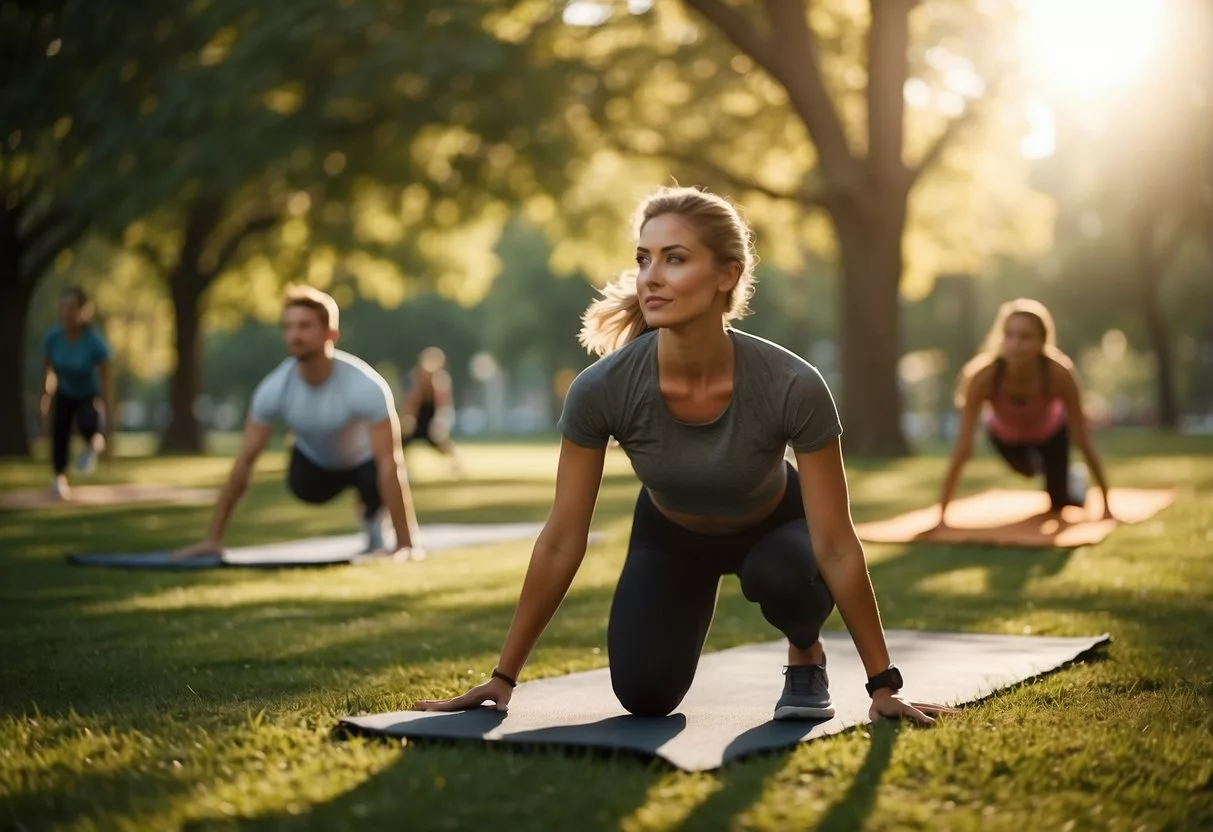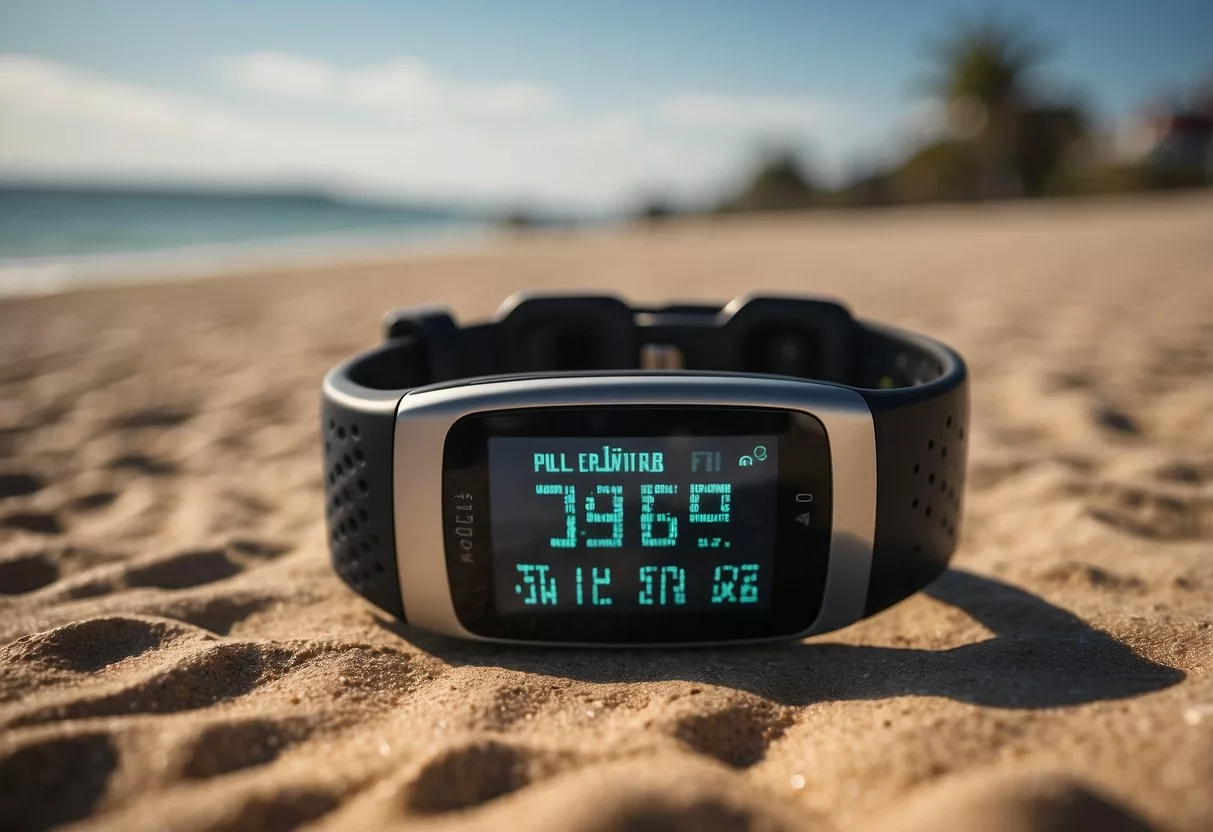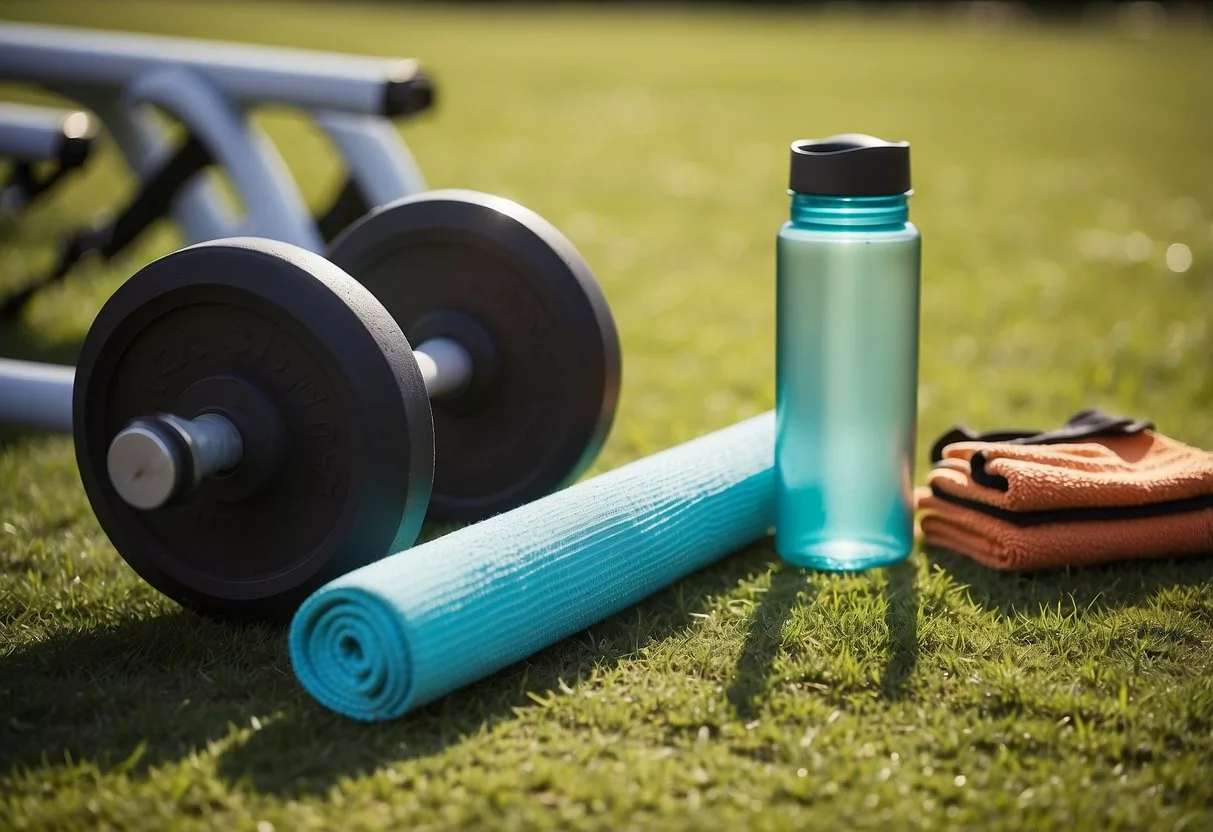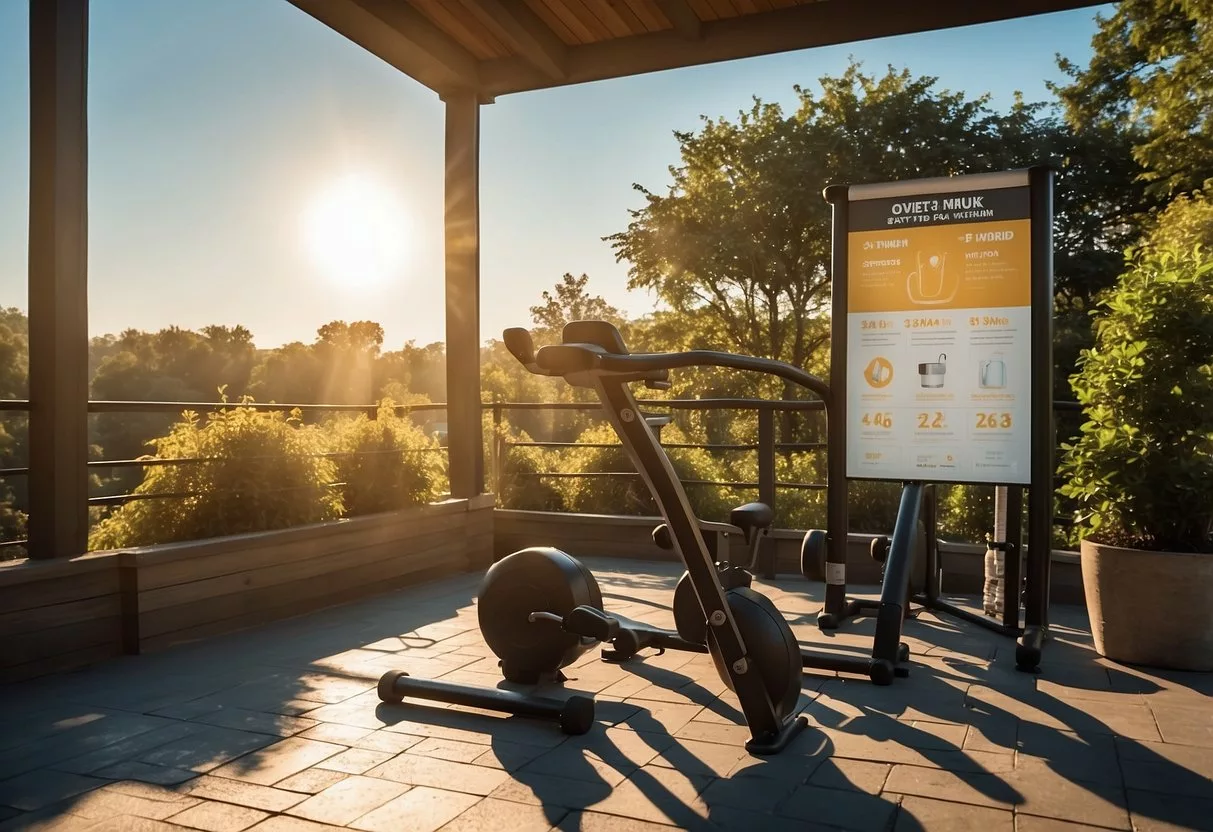Getting in shape for summer doesn’t have to be complicated. Whether you’re hitting the gym or working out at home, a good plan can change your results. A well-structured summer body workout plan not only tones muscles but also boosts confidence.

This four-week plan includes exercises that target your whole body. Strength workouts are essential, but don’t forget cardio and rest days. Balance your week with varied workouts and occasional rest to avoid burnout and injuries.
Nutrition is just as important as exercise. Eating a balanced diet and staying hydrated can enhance your progress and recovery. Combining these elements ensures you achieve your fitness goals this summer.
Key Takeaways
- A balanced plan includes strength, cardio, and rest.
- Nutrition boosts workout results and recovery.
- Varying workouts prevent boredom and injuries.
Setting Your Fitness Goals

The first step to achieving a summer-ready body involves setting clear and achievable fitness goals. Understanding your current capabilities, deciding on specific objectives, and maintaining a dedicated mindset will help you stay on track.
Evaluating Current Fitness Level
Start by assessing where you are now. Check your weight, body measurements, and fitness stats. This might include how many push-ups you can do, how far you can run, or your flexibility.
Fitness assessments can include:
- BMI calculation
- Strength tests (e.g., max push-ups, pull-ups)
- Endurance checks (e.g., running, cycling)
- Flexibility tests (e.g., touching toes)
Evaluating your current fitness allows you to establish a baseline, making it easier to track your progress. This can boost your motivation and provide a clearer picture of your starting point.
Determining Your Summer Body Objectives
Define exactly what you want to achieve by summer. Your goals might include losing weight, building muscle, or improving cardiovascular health.
Specific objectives should be:
- Measurable (e.g., lose 10 pounds)
- Time-bound
- Realistic (e.g., build noticeable muscle in arms)
It’s crucial to create a plan that outlines these targets. Writing down goals and having a timeline can keep you committed. Checking these smaller milestones frequently helps in maintaining a focused and positive mindset.
The Role of Consistency and Patience
Consistency and patience are key to seeing results. Regular workouts, balanced nutrition, and sufficient rest contribute significantly to progress.
Consider these tips:
- Follow a structured workout plan
- Eat a balanced diet with enough protein
- Ensure at least 7-8 hours of sleep each night
Staying consistent helps build habits, while patience allows your body the necessary time to adapt and improve. Tracking your progress with journals or apps can reinforce your motivation. Remember, changes happen gradually, and sticking to your routine will yield the best outcomes.
Workout Program Structure
Creating a summer body workout plan involves structured workouts that include specific splits, strength training, and cardiovascular exercises. Each of these components plays a crucial role in achieving balanced strength and muscle development.
Understanding Workout Splits
Workout splits refer to how exercise routines are divided throughout the week. Common splits include upper body and lower body days, or focusing on specific muscle groups each day.
A typical split might involve:
- Day 1: Upper body (Chest, Back)
- Day 2: Lower body (Legs, Glutes)
- Day 3: Rest or Active Recovery
- Day 4: Upper body (Arms, Shoulders)
- Day 5: Lower body (Legs, Calves)
- Day 6: Cardio and Abs
- Day 7: Complete Rest
This structure helps ensure that each muscle group gets adequate rest and recovery time between workouts.
Importance of Strength Training
Strength training is key for building muscle mass and increasing overall strength. It involves exercises like squats, deadlifts, bench presses, and rows.
Benefits of strength training include:
- Increased Muscle Mass: Helps create a toned appearance.
- Enhanced Metabolism: More muscle mass can lead to higher calorie burn.
- Improved Bone Density: Reduces the risk of osteoporosis.
A good program recommends at least three days of strength training per week. Each session should target major muscle groups to ensure balanced development.
Incorporating Cardiovascular Exercises
Cardiovascular exercises are essential for heart health and fat loss. They include activities like running, cycling, and swimming.
Important aspects of cardio include:
- Heart Health: Improves cardiovascular function and endurance.
- Calorie Burn: Helps in reducing body fat.
- Variety: Can be mixed with strength workouts for a balanced routine, as seen in this full-body workout[1].
Incorporating cardio can be done on alternate days from strength training or combined in the same session with exercises like burpees or jump rope to keep the heart rate up.
Weekly Workout Schedule
This schedule includes a balanced mix of strength, cardio, and rest. It’s designed to optimize your results and help you achieve a summer-ready body.
Week 1 Kickoff
In the first week, the focus is on getting used to the workout routine. Each day targets different muscle groups to build a strong foundation.
- Workout A (Monday and Thursday): Upper body exercises including bench press, push-ups, and bicep curls.
- Workout B (Tuesday and Friday): Lower body exercises such as squats, lunges, and deadlifts.
- Cardio and Abs (Wednesday and Saturday): 30 minutes of cardio (running, biking) and an ab circuit (planks, crunches).
- Rest Day (Sunday): No workouts. Focus on recovery with light stretching or yoga.
Make sure to use proper form and go at your own pace to avoid injuries.
Progression Through Weeks 2 to 4
From Week 2 onwards, the intensity gradually increases. This helps in building stamina and strength.
- Week 2:
- Workout A: Add more weight or increase reps.
- Workout B: Focus on compound movements like deadlifts.
- Cardio: Include HIIT sessions.
- Week 3:
- Workout A: Add supersets to increase intensity.
- Workout B: Include more dynamic moves like jump squats.
- Cardio: Mix in various cardio routines, like rowing or speed drills.
- Week 4:
- Workout A and B: Integrate advanced techniques like drop sets.
- Cardio: Extend cardio sessions to 45 minutes.
- Focus on explosive movements to boost power.
Consistency is key, so stick with the schedule for best results.
Adjustments and Variations
Tailor the workouts to match your fitness level. Beginners might need more rest, while advanced users could add extra sets or exercises.
- Variations:
- High-Intensity Intervals: Replace standard cardio with HIIT.
- Cross-Training: Add activities like swimming or cycling on rest days.
- Supersets: Combine two exercises back-to-back to save time and increase intensity.
- Adjustments:
- Weight: Increase gradually to avoid plateaus.
- Volume: Add more sets if workouts feel too easy.
- Rest Periods: Shorten rest periods to challenge yourself.
Modify the plan based on your progress and fitness goals. Ensure that every adjustment promotes growth and prevents burnout.
Essential Workouts Explained

A balanced summer body workout plan targets the upper body, lower body, and core. Different exercises for each area ensure comprehensive strength and muscle development.
Upper Body Exercises
Upper body exercises are essential for building strength and definition in the arms, chest, and shoulders. Push-ups and pull-ups are great bodyweight exercises that target multiple muscle groups. Bench presses with a barbell or dumbbells are key for chest development. Rows, either with dumbbells or a barbell, help strengthen the back muscles. Including variations ensures balanced development.
Lower Body Movements
The lower body includes the legs and glutes. Squats are effective for targeting quads, hamstrings, and glutes. Variations like front squats and goblet squats can add diversity. Deadlifts are crucial for the posterior chain, including the lower back and glutes. Using both barbell and dumbbells in exercises like lunges also improves balance and stability.
Core Strengthening Workouts
Core workouts focus on abdominal and lower back muscles. Planks are simple yet highly effective for building endurance. Russian twists engage the obliques, while leg raises target the lower abs specifically. Exercises like bicycle crunches combine upper and lower ab workouts. A strong core supports overall body strength and posture.
Nutrition and Recovery

Achieving your summer body goals requires not only a solid workout plan but also proper nutrition and recovery practices. Eating the right foods, staying hydrated, and getting adequate rest are crucial for performance and fat loss.
Eating for Performance and Fat Loss
Optimizing your diet for a summer workout plan involves consuming nutrient-dense foods. Focus on lean proteins such as chicken, fish, and tofu to support muscle repair and growth. Incorporate complex carbohydrates like brown rice, quinoa, and sweet potatoes to fuel workouts.
Healthy fats from sources like avocados, nuts, and olive oil can aid in fat loss and overall health. Aim to eat a balanced meal every 3-4 hours to maintain energy levels and support metabolism.
Hydration and Supplements
Proper hydration is essential. Aim to drink at least 8 glasses of water a day, and more if you are engaging in intense workouts. Dehydration can hinder performance and recovery.
Consider supplements like protein powder to meet daily protein needs and BCAAs to prevent muscle breakdown during exercise. Electrolyte drinks are helpful for replenishing minerals lost through sweat.
Rest and Active Recovery
Rest days are crucial for muscle repair and growth. Ensure you get at least 7-8 hours of sleep each night. This helps the body recover and perform better in subsequent workouts.
Incorporate active recovery activities like yoga, stretching, or light cardio on non-training days. These activities can enhance blood flow and reduce muscle soreness without adding stress to the body.
Tracking Progress and Staying Motivated

Tracking your progress and staying motivated are crucial to achieving your summer body workout goals. By keeping an eye on results and adjusting your fitness goals and routines, you can maintain your enthusiasm and make the most of your efforts.
Monitoring Body Changes
Monitoring changes in your body can help you understand the impact of your workout plan. Take regular measurements such as weight, body fat percentage, and muscle mass.
Progress photos are also a useful tool. Snap pictures every two weeks in consistent lighting and clothing. Keep a workout journal to note how your body feels after workouts, and track improvements in strength and endurance.
Using apps and fitness trackers can simplify this process. They provide detailed metrics on your workouts and recovery, helping you stay on top of your progress. Track your body fat percentage to see changes in muscle and fat composition over time.
Adjusting Goals and Workouts
As you progress, you’ll likely need to adjust your goals and workouts. Set short-term targets that lead to your long-term fitness objectives. If you’ve reached a plateau or find certain exercises too easy, modify your routine.
Incorporate variety to keep workouts challenging and engaging. Updated goals should reflect changes in your fitness level and keep you motivated. For example, if you initially focused on weight loss, you might shift to muscle building as your fitness improves.
Consulting with a trainer can provide personalized advice. They can help you make necessary adjustments to your plan, ensuring you continue to see progress. Adjusting nutrition and rest are also important aspects of staying on track and maintaining motivation toward your fitness goals.
Support and Gear

Having the right support and gear can make a big difference in reaching your fitness goals. From selecting the right workout clothes to finding a workout buddy, make sure you are well-equipped for optimal results.
Choosing the Right Workout Gear
The right workout gear can enhance performance and prevent injury. Opt for comfortable, moisture-wicking clothing to keep you dry during workouts. Breathable fabrics such as mesh or cotton blends are good choices. Proper footwear is crucial. Choose athletic shoes designed for your specific activities. Running shoes, for example, offer different support compared to cross-training shoes.
Compression gear can provide extra support to muscles and improve circulation. Accessories like gloves or wrist wraps can help lift weights safely and avoid strain. Consider investing in a quality gym bag to keep all your gear organized.
Finding a Workout Buddy or Personal Trainer
A workout buddy or personal trainer can provide motivation and accountability. A reliable workout buddy helps stay consistent and makes exercise more enjoyable. They can offer encouragement and share similar fitness goals.
Personal trainers tailor fitness plans to meet individual needs, ensuring proper form and technique. They provide expert guidance and adjust routines as needed to maximize results. Trainers also offer knowledge on effective workouts and nutrition tips. Investing in a personal trainer can significantly enhance the effectiveness of a summer body workout plan.
Working with someone else can lead to increased commitment and better results, making the fitness journey more successful.
Safety Tips and Considerations

Ensuring safety during summer workouts involves proper form to prevent injuries and making adjustments for different skill levels.
Preventing Injuries with Proper Form
Maintaining proper form is crucial to avoid injuries, especially during summer workouts.
- Start with a Warm-Up: Always begin with a 5-10 minute warm-up to prepare muscles and joints.
- Maintain Alignment: Keep your body aligned during exercises to avoid unnecessary strain.
- Use Proper Equipment: Wear supportive shoes and use gear suited for your workout.
- Hydrate Frequently: Drink water before, during, and after exercise to prevent dehydration.
- Listen to Your Body: If you feel pain or discomfort, stop immediately and rest.
Focusing on these points can help reduce the risk of injury and improve overall workout effectiveness.
Adjustments for Different Skill Levels
Tailoring workouts to suit different skill levels helps ensure safety for everyone.
- Beginners: Start with low-intensity exercises and shorter durations.
- Intermediate: Gradually increase intensity and duration as endurance builds.
- Advanced: Incorporate high-intensity workouts but always include a cool down to prevent muscle soreness.
- Adapt as Needed: Modify exercises to match your capability, and never push beyond comfort.
- Seek Guidance: Working with a fitness professional can help tailor a plan that fits your skill level.
These adjustments ensure that everyone, regardless of experience, can work out safely.
Summer Workout Challenge

Tackling a summer workout challenge can boost fitness levels and motivate personal bests. Breaking the routine into weekly goals makes it manageable and fun.
Weekly Challenge Breakdown
Each week in the challenge focuses on different muscle groups and goals. For example, Muscle & Strength’s plan begins with upper body supersets, followed by lower body routines. Cardio and abs are incorporated midweek and weekends have rest or light activities.
Here’s a sample breakdown:
- Day 1: Upper Body Superset
- Day 2: Lower Body Superset
- Day 3: Cardio and Abs
- Day 4: Repeat Upper Body Superset
- Day 5: Repeat Lower Body Superset
- Day 6: More Cardio and Abs
- Day 7: Rest Day
This structure keeps workouts diverse and targets all major muscle groups effectively.
Evaluating and Sharing Results
As participants progress, evaluating performance is key. They should note improvements in strength, endurance, and overall fitness. Many find it helpful to track their progress using a journal or app.
Sharing results within a community can boost motivation. Platforms like Muscle & Fitness[2] encourage participants to post updates and photos. Engaging with others on similar journeys fosters camaraderie and a sense of achievement as everyone strives toward their personal bests. Regular check-ins and positive feedback help maintain commitment to the challenge.
Frequently Asked Questions

This section answers common questions about summer body workout plans, covering the best routines, gender-specific tailoring, beginner-friendly exercises, weight loss workouts, home-based plans, and the timeframe for visible results.
What are the best workout routines for achieving a summer body?
Full-body workouts that target major muscle groups, like squats, lunges, push-ups, and rows, are effective. These exercises engage multiple muscles and maximize gym time, promoting balanced strength and muscle development. Combining strength training with cardio maximizes fat and calorie burn.
How can I tailor a workout plan for summer body goals specific to my gender?
In general, men might focus more on building muscle mass with heavier weights, while women might incorporate more cardio and light to moderate weights for a toned look. Both should focus on a balanced mix of strength, cardio, and flexibility exercises.
What are effective beginner-friendly exercises for a summer body workout plan?
Beginners can start with basic bodyweight exercises. Squats, push-ups, lunges, and planks are simple yet effective. These exercises help build strength and endurance. Starting with these before moving on to weighted exercises can help prevent injury and build confidence.
Which exercises should be included in a summer body workout plan for weight loss?
Incorporate high-intensity interval training (HIIT) and resistance training. Exercises like burpees, mountain climbers, jump squats, and sprints increase heart rate and burn calories quickly. Including weighted exercises like deadlifts and bench presses can enhance muscle growth and metabolism.
Can you recommend a summer body workout plan that can be done at home?
A home-based plan can include exercises like push-ups, bodyweight squats, lunges, and burpees. Resistance bands and dumbbells can add variety. A plan could look like this: Day 1 – Upper Body, Day 2 – Lower Body, Day 3 – Cardio, and Abs, Day 4 – Rest, repeat as needed.
What is the timeframe required to see visible results from a summer body workout?
Visible results often take about 4-8 weeks. Consistency with workouts and a healthy diet are key. It’s essential to rest adequately and stay hydrated. Regularly monitoring progress and making necessary adjustments can help achieve goals more effectively.
References
- The Best Full-Body Summer Workout Plan. https://www.muscleandfitness.com/routine/workouts/workout-routines/summer-full-body-workout-routines/ Accessed October 25, 2025
- The Six Week Summer Body Workout Program. https://www.muscleandfitness.com/workout-plan/workouts/workout-routines/six-week-summer-cleaning-workout-0/ Accessed October 25, 2025
